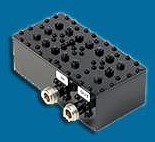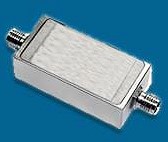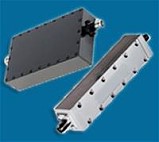|

Sam Benzacar of Anatech Electronics, an RF and microwave filter company, has published
his June 2023 newsletter that features his short op-ed entitled "Filters Save the
Day." In it, Sam discusses how two of the biggest issues of the day concerning
RF interference - the coexistence of C-band cellphone service and radar
altimeters, and AM radio in electric vehicles - are relatively easily solved
with filters. I have posted links to many news stories covering both challenges
in the last few years. Sam makes a good point about the AM radio in EV's*, that
being whereas car manufacturers say the noise generated by the propulsion
systems (brushless motors which run on high frequency pulses) will wreak havoc
with AM radio, there will certainly be other susceptibilities needing to be
dealt with by onboard systems. I will add that dense urban environments filled
with EMI-spewing EV's might also cause serious problems for external systems as
the ambient noise floor rises ever higher. Time will tell.
*
AM for Every Vehicle Act
A Word from Sam Benzacar - Filters Save the Day
 By Sam Benzacar By Sam Benzacar
As we've been manufacturing RF filters for more than three decades, we pay
attention when something interesting turns up in the news that concerns RF
filters. There were two notable instances of this in the last two years. The
first, which received massive attention, was the claim that as wireless carriers
deployed their new C-band frequencies near airports, they posed a hazard to the
airline industry because the signal could degrade the performance of aircraft
altimeters when aircraft were landing.
The issue was that the frequencies used by the altimeters and the carriers
are so close that the C-band out-of-band emissions could splatter into the band
used by the altimeters. The C-band frequencies allocated for carriers are from
3.7 to 3.98 GHz, and radio altimeters operate between 4.2 and 4.4 GHz. Just
before carriers were authorized to begin C-band operation, Boeing and Airbus
asked the U.S. government to put a hold on the rollout. They were concerned that
C-band-enabled base stations close to airports could interfere with radio
altimeters on aircraft that are landing, and they were joined by the entire
commercial airline industry. This left the FAA and FCC to figure out a solution.
After about two years of back-and-forth negotiations, the FCC finally decided
that, among other remedies, as some altimeters are more susceptible to
interference than others, "certain" aircraft needed to retrofit their altimeters
with bandpass filters to reduce interference. This conclusion should not have
taken two years because the solution was obvious from the beginning: better
bandpass filters.
The second issue arose when BMW, Ford, Mazda, Polestar, Rivian, Tesla,
Volkswagen, and Volvo said they would eliminate AM radios from their EVs. Their
stated reason was that the noise created by their electric motors would
interfere with AM reception, although I suspect there was a cost element to
this. The automakers seem to believe that as AM radio is archaic, and the number
of listeners has been dropping for years, there's no need for AM receivers in
their EVs.
While everyone reading this well knows that electric motors cause
interference, so does almost everything else in a vehicle that relies on
electronic components to perform almost every function. So, the question is,
once more and more EVs take to the road, will they effectively be big noise
generators on wheels? And if that's the case, RF filters will need to play a big
role in keeping their interference in check. The media seems to have missed
that, as I found not a single article mentioning the topic.
Fortunately, the automaker's decision brought a big blowback in Congress. A
bill introduced by Senator Ed Markey (D-MA) in the Senate called the AM Radio
for Every Vehicle Act would mandate to mandate that AM be included in all cars
sold in the U.S. as a standard feature without any additional cost to new car
buyers. Rep. Josh Gottheimer (D-NJ) introduced a similar bill in the House, and
both bills have bipartisan support.
Their issue wasn't interference but that AM radio is an essential part of
America's emergency alert infrastructure and the backbone behind America's
National Public Warning System, for emergency-alert info from FEMA to the public
during natural disasters, extreme weather, chemical incidents, health
emergencies, and domestic threats. That is, the frequencies at which AM radio
operates can travel hundreds or even thousands of miles under certain
conditions, making it the only way people in rural areas can receive alerts.
While the altimeter issue was a no-brainer, the EV issue isn't so simple,
especially considering that no one seems to be discussing it. My guess is that
there will be a lot of RF filters in the EVs of the future.
Aliens Challenged to Decode SETI Message
 Rather than sending messages in English or some other language into space and
awaiting a response, the SETI Institute is trying a new tactic: sending an encoded
message that they hope simulates one from an advanced extraterrestrial civilization
that could, after deciphering it, send it back to Earth. So, it would be up to whomever
(or whatever) life form gets the message to figure out what it means. The message
was sent from the European Space Agency's ExoMars Trace Gas Orbiter (TGO satellite)
in a program called A Sign From Space. Rather than sending messages in English or some other language into space and
awaiting a response, the SETI Institute is trying a new tactic: sending an encoded
message that they hope simulates one from an advanced extraterrestrial civilization
that could, after deciphering it, send it back to Earth. So, it would be up to whomever
(or whatever) life form gets the message to figure out what it means. The message
was sent from the European Space Agency's ExoMars Trace Gas Orbiter (TGO satellite)
in a program called A Sign From Space.
The program was dreamed up by Daniela De Paulis, an artist in residence at the
SETI Institute, who brought together a team of international experts to work on
the program. Its contents remain unknown even to most collaborating partners. The
signal was received by astronomers at the Green Bank Observatory, the Allen Telescope
Array, and the Medicina Radio Astronomical Station, who removed the telemetry data
and posted the remaining encoded message on the project's website for anyone to
download. It's now up to the people of Earth to crack the code and interpret the
message.
Caltech Shows Energy Can Be Beamed to Earth
 Researchers at the California Institute of Technology (Caltech), using their
Space Solar Power Demonstrator (SSPD-1), demonstrated that sending energy from space
to Earth might be possible. It uses the Microwave Array for Power-transfer Low-orbit
Experiment (MAPLE) that beams the energy to desired locations. The transmitted energy
was detected by a receiver on the roof of the Gordon and Betty Moore Laboratory
of Engineering on Caltech's campus in Pasadena. The received signal appeared at
the expected time and frequency and had the right frequency shift as predicted based
on its predicted travel from orbit. When fully realized, SSPP will deploy a spacecraft
constellation that collects sunlight, transforms it into electricity, and then converts
it to microwave energy transmitted wirelessly to wherever it is needed. Researchers at the California Institute of Technology (Caltech), using their
Space Solar Power Demonstrator (SSPD-1), demonstrated that sending energy from space
to Earth might be possible. It uses the Microwave Array for Power-transfer Low-orbit
Experiment (MAPLE) that beams the energy to desired locations. The transmitted energy
was detected by a receiver on the roof of the Gordon and Betty Moore Laboratory
of Engineering on Caltech's campus in Pasadena. The received signal appeared at
the expected time and frequency and had the right frequency shift as predicted based
on its predicted travel from orbit. When fully realized, SSPP will deploy a spacecraft
constellation that collects sunlight, transforms it into electricity, and then converts
it to microwave energy transmitted wirelessly to wherever it is needed.
Wireless Broadband Moves In
 The cable industry may be in decline, but 5G wireless broadband delivery to homes
is increasing and becoming a viable option. It can deliver speeds comparable to
fiber and allows customers to set up their service without a professional installation,
which for service providers is a huge benefit as a fiber installation can talk the
better part of a day. As a result, it's projected to surpass 1 billion users by
2030, an annual growth rate of about 47%, according to Counterpoint Research. However,
its performance will vary depending on the location and network coverage, so it's
still a work in progress. The cable industry may be in decline, but 5G wireless broadband delivery to homes
is increasing and becoming a viable option. It can deliver speeds comparable to
fiber and allows customers to set up their service without a professional installation,
which for service providers is a huge benefit as a fiber installation can talk the
better part of a day. As a result, it's projected to surpass 1 billion users by
2030, an annual growth rate of about 47%, according to Counterpoint Research. However,
its performance will vary depending on the location and network coverage, so it's
still a work in progress.
Amazon May Add Mobile to the Primes Bundle
 According to Bloomberg, although all the major carriers and even Amazon deny
it, the e-commerce goliath may be considering adding low-cost mobile service to
its Prime bundle. The wireless industry could benefit, as Amazon might attract more
traffic to its 5G networks, but it could also eat into its customer base if the
cost is low enough and doesn't leave out key features currently available only from
the carriers themselves. Mobile virtual network operators (MVNO), which Amazon Would
become if it offered the service, have been around for years, including Google Fi,
Boost Mobile, Mint Mobile, Straight Talk, and Walmart's Family Mobile. The rumor
is that Amazon would offer its perk for $10 a month or even for nothing for Prime
members. According to Bloomberg, although all the major carriers and even Amazon deny
it, the e-commerce goliath may be considering adding low-cost mobile service to
its Prime bundle. The wireless industry could benefit, as Amazon might attract more
traffic to its 5G networks, but it could also eat into its customer base if the
cost is low enough and doesn't leave out key features currently available only from
the carriers themselves. Mobile virtual network operators (MVNO), which Amazon Would
become if it offered the service, have been around for years, including Google Fi,
Boost Mobile, Mint Mobile, Straight Talk, and Walmart's Family Mobile. The rumor
is that Amazon would offer its perk for $10 a month or even for nothing for Prime
members.
Anatech Electronics Introduces a New Line of Suspended
Stripline and Waveguide Type RF Filters
Check out Our Filter Products



Cavity Band Pass Filters
LC Band Pass Filters Cavity Bandstop/Notch Filter
About Anatech Electronics
Anatech Electronics, Inc. (AEI) specializes in the design and manufacture of
standard and custom RF and microwave filters and other passive components and subsystems
employed in commercial, industrial, and aerospace and applications. Products are
available from an operating frequency range of 10 kHz to 30 GHz and include cavity,
ceramic, crystal, LC, and surface acoustic wave (SAW), as well as power combiners/dividers,
duplexers and diplexers, directional couplers, terminations, attenuators, circulators,
EMI filters, and lightning arrestors. The company's custom products and capabilities
are available at www.anatechelectronics.com.
Contact:
Anatech Electronics, Inc.
70 Outwater Lane
Garfield, NJ 07026
(973)
772-4242
sales@anatechelectronics.com
Posted June 22, 2023
|





























 By Sam Benzacar
By Sam Benzacar Rather than sending messages in English or some other language into space and
awaiting a response, the SETI Institute is trying a new tactic: sending an encoded
message that they hope simulates one from an advanced extraterrestrial civilization
that could, after deciphering it, send it back to Earth. So, it would be up to whomever
(or whatever) life form gets the message to figure out what it means. The message
was sent from the European Space Agency's ExoMars Trace Gas Orbiter (TGO satellite)
in a program called A Sign From Space.
Rather than sending messages in English or some other language into space and
awaiting a response, the SETI Institute is trying a new tactic: sending an encoded
message that they hope simulates one from an advanced extraterrestrial civilization
that could, after deciphering it, send it back to Earth. So, it would be up to whomever
(or whatever) life form gets the message to figure out what it means. The message
was sent from the European Space Agency's ExoMars Trace Gas Orbiter (TGO satellite)
in a program called A Sign From Space.  Researchers at the California Institute of Technology (Caltech), using their
Space Solar Power Demonstrator (SSPD-1), demonstrated that sending energy from space
to Earth might be possible. It uses the Microwave Array for Power-transfer Low-orbit
Experiment (MAPLE) that beams the energy to desired locations. The transmitted energy
was detected by a receiver on the roof of the Gordon and Betty Moore Laboratory
of Engineering on Caltech's campus in Pasadena. The received signal appeared at
the expected time and frequency and had the right frequency shift as predicted based
on its predicted travel from orbit. When fully realized, SSPP will deploy a spacecraft
constellation that collects sunlight, transforms it into electricity, and then converts
it to microwave energy transmitted wirelessly to wherever it is needed.
Researchers at the California Institute of Technology (Caltech), using their
Space Solar Power Demonstrator (SSPD-1), demonstrated that sending energy from space
to Earth might be possible. It uses the Microwave Array for Power-transfer Low-orbit
Experiment (MAPLE) that beams the energy to desired locations. The transmitted energy
was detected by a receiver on the roof of the Gordon and Betty Moore Laboratory
of Engineering on Caltech's campus in Pasadena. The received signal appeared at
the expected time and frequency and had the right frequency shift as predicted based
on its predicted travel from orbit. When fully realized, SSPP will deploy a spacecraft
constellation that collects sunlight, transforms it into electricity, and then converts
it to microwave energy transmitted wirelessly to wherever it is needed.  The cable industry may be in decline, but 5G wireless broadband delivery to homes
is increasing and becoming a viable option. It can deliver speeds comparable to
fiber and allows customers to set up their service without a professional installation,
which for service providers is a huge benefit as a fiber installation can talk the
better part of a day. As a result, it's projected to surpass 1 billion users by
2030, an annual growth rate of about 47%, according to Counterpoint Research. However,
its performance will vary depending on the location and network coverage, so it's
still a work in progress.
The cable industry may be in decline, but 5G wireless broadband delivery to homes
is increasing and becoming a viable option. It can deliver speeds comparable to
fiber and allows customers to set up their service without a professional installation,
which for service providers is a huge benefit as a fiber installation can talk the
better part of a day. As a result, it's projected to surpass 1 billion users by
2030, an annual growth rate of about 47%, according to Counterpoint Research. However,
its performance will vary depending on the location and network coverage, so it's
still a work in progress.  According to Bloomberg, although all the major carriers and even Amazon deny
it, the e-commerce goliath may be considering adding low-cost mobile service to
its Prime bundle. The wireless industry could benefit, as Amazon might attract more
traffic to its 5G networks, but it could also eat into its customer base if the
cost is low enough and doesn't leave out key features currently available only from
the carriers themselves. Mobile virtual network operators (MVNO), which Amazon Would
become if it offered the service, have been around for years, including Google Fi,
Boost Mobile, Mint Mobile, Straight Talk, and Walmart's Family Mobile. The rumor
is that Amazon would offer its perk for $10 a month or even for nothing for Prime
members.
According to Bloomberg, although all the major carriers and even Amazon deny
it, the e-commerce goliath may be considering adding low-cost mobile service to
its Prime bundle. The wireless industry could benefit, as Amazon might attract more
traffic to its 5G networks, but it could also eat into its customer base if the
cost is low enough and doesn't leave out key features currently available only from
the carriers themselves. Mobile virtual network operators (MVNO), which Amazon Would
become if it offered the service, have been around for years, including Google Fi,
Boost Mobile, Mint Mobile, Straight Talk, and Walmart's Family Mobile. The rumor
is that Amazon would offer its perk for $10 a month or even for nothing for Prime
members. 




